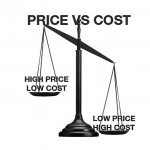The True Cost of Janitorial
Price versus cost.
Many would think this is the same.
But the reality is they are not even close. The price is what you pay for a given item when you purchase from your vendor. The cost is based on how long it will last (dilution or longevity of item) and how effective it will work to make the job better, faster, or easier. Just because a gallon of floor stripper is five dollars less in price does not mean it is a good buy. What if the higher priced floor stripper has a dilution ratio four times higher (1: 4 vs 1:16) and works better at removing the finish quicker, better, and easier? Granted, you would spend less cash up front when you purchase the product but you will wind up purchasing more product to do the same amount of square feet and spend much more on labor because the product is not effective.
The most expensive line item of any budget for janitorial service is LABOR. The amount of time it takes the custodian to complete the job or task, with the tools & chemicals provided to them, is by far the most expensive part of the overall equation on what it cost to complete the job. How much someone pays for a tool, widget, or chemical is not what should be looked at first. Quality and time saving ability is what everyone should be laser focused on as first importance.
Take into example an arbitrary thousand foot square floor – Why not purchase a ten dollar corn broom for the custodian to sweep this floor? According to the ISSA standard times, it would take a custodian 25.2 minutes. What about this same task with a 24 inch treated dust mop (price $20.00)? Now the task only takes 7.2 min. Just looking at PRICE we would make the decision of the broom that is half the price of the dust mop. So what is the major cost of this job the LABOR or the cost of the broom or dust mop?  It’s the LABOR!!! Smarter tools that bring more efficient and higher productivity to the worker will give the School or Contract Cleaner more profit through greater productivity.
It’s the LABOR!!! Smarter tools that bring more efficient and higher productivity to the worker will give the School or Contract Cleaner more profit through greater productivity.
This same argument works with chemicals in respect to their dilution rates, quality, and effectiveness. This past decade has seen many school districts implement cuts in their custodial staffing. Many schools have now chosen to purchase auto scrubbers, large dust mops and other modern tools that will assist them in getting the same amount of work done with fewer people. However – many of these schools will also put the chemicals out for bid and the sole criteria will be price of the gallon regardless of how much a gallon will make when diluted or how effective it is on the floor.

School Districts across the country are faced with budget battles. Decreases in funding almost always seem to impact available funds for facility maintenance.
Purchasing departments (and building contractors) need to be educated on the difference between price versus cost. The purchasing departments in many school districts are highly educated, but also short staffed. In most cases, they have not been educated in the area of price versus cost when it comes to janitorial supplies and in particular, chemicals. Personally, I have seen machinery and tools specked on a few bids to almost a serial number on a machine but chemicals are more often than not listed as “stripper 5gl pail” or “finish – wet look, 5gl pail”. No specifications are listed on quality, percentage of actives in the stripper, dilution ratios, percentage of solids in the finish, or durability. It would be great for school organizations like ASBO or other organization to help bring this issue to the schools’ purchasing and administrative officials. This education would help them make a better decision that will allow them to lower their overall cost of business and get more done with less people. Without groups like this bringing the training to their people then it is up to us to help educate the educators, one school at a time.
Many school districts don’t want to look at this information and use the argument of “we have to go out for bid”. Well, that just is not true and we all know that. Request for Proposals (RFP) allow for more criteria to be listed and awarding of the RFP can be based on more than just price. Even if you have to go out for bid, you can simply speck more specific items on each chemical, such as: dilution ratios not less than a certain criteria, percentage of actives at 55% or greater, etc. Procurement buyers could also speck the brand or brands, stay with the major chemical brands on the market, and avoid products made in someone’s back yard. Those homemade products just do not work well in the real word, but have a cheap gallon price for bids.
Building Service Contractors (BSC) get this better then school’s because they are directly responsible for their bottom line and profitability. BSC’s have learned that if they use a better floor finish then they don’t have to strip a school’s floor every year and will only strip about every three to five years. This is why BSC’s are now, more than ever, cleaning more school systems across this country with greater effectiveness and lower cost, while (yes) making a profit.
Schools have the ability to change this trend if they decide to look more at COST and not PRICE when making purchasing decisions. Remember that the true cost of a chemical or tool is not the price you pay at the register!
 English
English Español
Español

